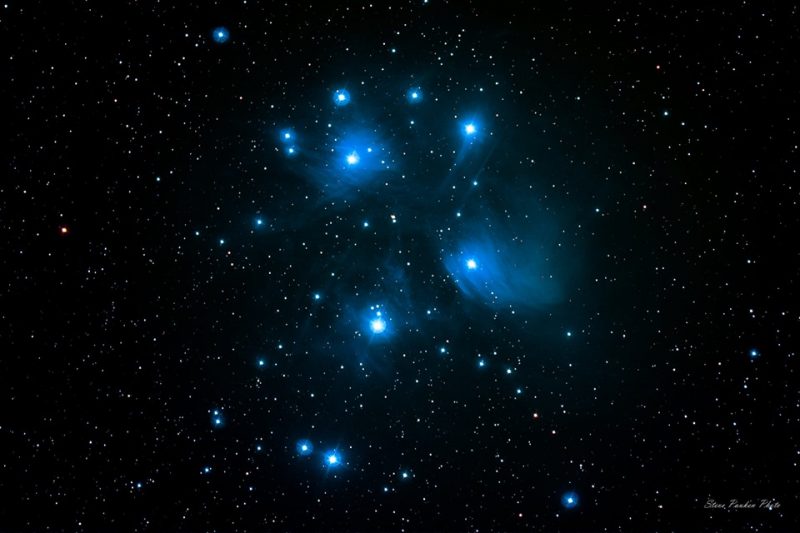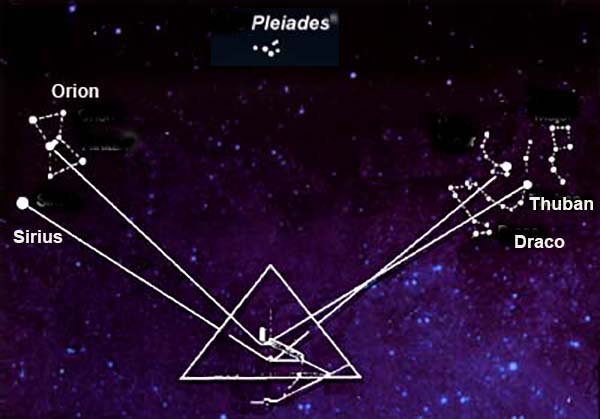



The Pleiades also known as the Seven Sisters and Messier 45, are an open star cluster containing middle-aged, hot B-type stars located in the constellation of Taurus. It is among the nearest star clusters to Earth and is the cluster most obvious to the naked eye in the night sky.
The cluster is dominated by hot blue and extremely luminous stars that have formed within the last 100 million years. Dust that forms a faint reflection nebulosity around the brightest stars was thought at first to be left over from the formation of the cluster (hence the alternative name Maia Nebula after the star Maia), but is now known to be an unrelated dust cloud in the interstellar medium, through which the stars are currently passing. Computer simulations have shown that the Pleiades were probably formed from a compact configuration that resembled the Orion Nebula. Astronomers estimate that the cluster will survive for about another 250 million years, after which it will disperse due to gravitational interactions with its galactic neighborhood.
The name of the Pleiades comes from Ancient Greek. It probably derives from plein ("to sail") because of the cluster's importance in delimiting the sailing season in the Mediterranean Sea: "the season of navigation began with their heliacal rising". However, in mythology the name was used for the Pleiades, seven divine sisters, the name supposedly deriving from that of their mother Pleione and effectively meaning "daughters of Pleione". In reality, the name of the star cluster almost certainly came first, and Pleione was invented to explain it. Read more
The high visibility of the Pleiades in the night sky has guaranteed it a special place in many cultures, both ancient and modern. The heliacal rising of Pleiades often marks important calendar points for ancient peoples.
The Pleiades are a prominent sight in winter in the Northern Hemisphere, and are easily visible out to mid-Southern latitudes. They have been known since antiquity to cultures all around the world, including the Celts, Hawaiians, Maori, Aboriginal Australians (from several traditions), the Persians, the Arabs, Chinese, the Quechua, the Japanese, the Maya, the Aztec, the Sioux, the Kiowa, and the Cherokee. In Hinduism, the Pleiades are known as Krittika and are associated with the war-god Kartikeya. They are also mentioned in the Bible. Pleiades in Folklore and Literature
Astronomers Uncover a Massive Hidden Structure Around the Pleiades Star Cluster SciTech Daily - November 12, 2025

Astronomers have discovered that the iconic Pleiades cluster, long admired as the 'Seven Sisters,' is only a small part of a much larger stellar family stretching across the sky.
Pleiades: An Ancient Human Story About The Seven Sisters May Have Survived From 100,000 BCE IFL Science - February 14, 2024
In the northern hemisphere from October to March, you can look up and see the Pleiades, also known as the Seven Sisters. The star cluster is in the constellation of Taurus, and made up of over 1,000 stars, but the brightest of the stars are hot blue luminous stars which formed around 100 million years ago.

The earliest-known depiction of the Pleiades is likely a Northern German bronze
age artifact known as the Nebra Sky Disk, dated to approximately 1600 BC.

When you research extraterrestrials you often connect with Orion and Sirius as well as the Pleiades - their myths connected to those who traveled to Earth in the ancient past sometimes leaving monuments behind as markers for their time here and possible return in the future.
These are the extraterrestrials who go by many names and have created legends along the line of ... "One day we shall return". People who "channel" aliens often say they come from these three main places which include the Pleiades.
The sacred geometry linking all of the above speaks to something greater than what we see. I call it a Simulation or Matrix.
Human-alien connections take us to the Pleiades as one of the most fascinating threads running through ancient-mystery and ancient-alien traditions worldwide. Across distant cultures and millennia, the same seven stars show up in creation stories, myths of return, and cosmic ancestry tales. Ancient aliens allegedly ...
Visited Earth in antiquity
Taught early humans architecture, astronomy, and spirituality
Were later deified by multiple cultures under different names (e.g., the Anunnaki of Mesopotamia, the Hathors (Egypt), or the Sky People (Native American).
Maya and Aztec were The Timekeepers of the Pleiades - They used the Pleiades to mark world ages and cosmic cycles. During the New Fire Ceremony every 52 years, priests watched the Pleiades reach zenith - if the stars appeared, the world would continue. Interpreted as a reconnection point with the gods - possibly visitors returning from the Pleiades.
Hopi (North America) - The Hopi say their ancestors came from the Chuhukon, meaning 'those who came from the Pleiades.' The cluster is central to their kachina traditions - spiritual messengers who teach balance with the Earth. Ancient-alien lens: the kachinas were extraterrestrial beings who educated early humans in ethics and agriculture.
Japan - Subaru meaning to unite, is the Japanese name for the cluster (and the car brand’s logo of six stars).
Linked to ancestral origins and harmony. In esoteric interpretations, the Japanese mythic descent of the gods from heaven is tied to those stars.
Polynesian and Aboriginal Traditions - Maori (New Zealand): Matariki - the stars that mark the New Year, associated with rebirth and ancestors returning from the heavens.
Aboriginal Australians: the Pleiades are 'the Seven Sisters,' pursued across the sky by Orion - a story dating back tens of thousands of years. Some theorists see this as a memory of sky beings interacting with early humanity.
The Pleiades system was a hub or origin point for extraterrestrial civilizations.
These beings visited Earth in antiquity, seeding cultures and knowledge.
The myths of 'returning gods' reflect memories of contact - possibly promising another visit when the Pleiades align again with Earth's great monuments.
According to ancient astronaut theory, the Pleiades star cluster is believed to align with - or be symbolically linked to - several major pyramid complexes around the world. Proponents of this theory argue that ancient civilizations built pyramids in alignment with specific stars, particularly the Pleiades, which many cultures revered as the home of celestial gods.
Here are the main sites said to align with or correspond to the Pleiades according to that viewpoint:
1. The Pyramids of Teotihuacan (Mexico) Claim: The layout of the Pyramid of the Sun, Pyramid of the Moon, and the Temple of Quetzalcoatl mirrors the pattern of the Pleiades.
Theory: The ancient Aztecs (and earlier Toltecs or Teotihuacanos) tracked the Pleiades as part of their "New Fire" ceremony, which marked the renewal of the world every 52 years.
Significance: The Pleiades reached the zenith (directly overhead) at midnight during these cycles - believed to signify cosmic renewal or contact with gods.
2. The Giza Pyramids (Egypt)
Claim: While mainstream Egyptology notes the Giza pyramids align with Orion's Belt, some alternative theorists extend this to say that the Pleiades corresponds to the stars near Orion (like Taurus, which hosts the Pleiades).
Interpretation: The Great Pyramid may have symbolic links to both Orion (Osiris) and the Pleiades (Isis or Hathor) - dual cosmic energies in Egyptian mythology.
3. The Pyramids of China (Xi'an region)
Claim: "The White Pyramid" and nearby mounds in Shaanxi province are said to form a pattern similar to the Pleiades cluster.
Theory: These massive burial mounds may have been built to mirror the stars that ancient Chinese astronomers called the 'Hairy Head,' their name for the Pleiades.
4. The Seven Pyramids of Tenerife (Canary Islands)
Claim: The Guanches (ancient inhabitants) constructed pyramids said to correspond to the seven visible stars of the Pleiades.
Mythic Link: Some accounts suggest the Guanches considered themselves descendants of beings from the stars, tying their cosmology to that cluster.
The ancestral connection to the Pleiades arises because they represent the place heaven meets heritage - the cosmic memory of who we were, and the promise of who we might become.
In modern metaphysical and starseed belief systems, the Pleiades are described as the home of benevolent, enlightened beings who once guided humanity.
People who sense kinship with the Pleiades often identify as Pleiadian souls - incarnated here to help Earth evolve spiritually.
The feeling of connection is seen as a remembrance of cosmic ancestry
The purpose of any myth or soul connection is to allow humanity to know that they are part of a greater cosmological blueprint.

The Pleiades was one of the first stops on my metaphysical journey in the 1980s. In the back room of a bookstore in Manhattan, I found a tabletop book called UFO ... Contact From the Pleiades, written and designed by Brit and Lee Elders. It awakened something in me that had been told in 1954 at age 11 when I was "taken" on a UFO - and my future foretold. The rest is history.
Though I don't feel a direct connection with the Pleiades - perhaps more with Sirius and Orion - it was my jump-off point for remembering about who I am and why I am here. I hope you find yours

Billy Meier and Pleiadian Contacts